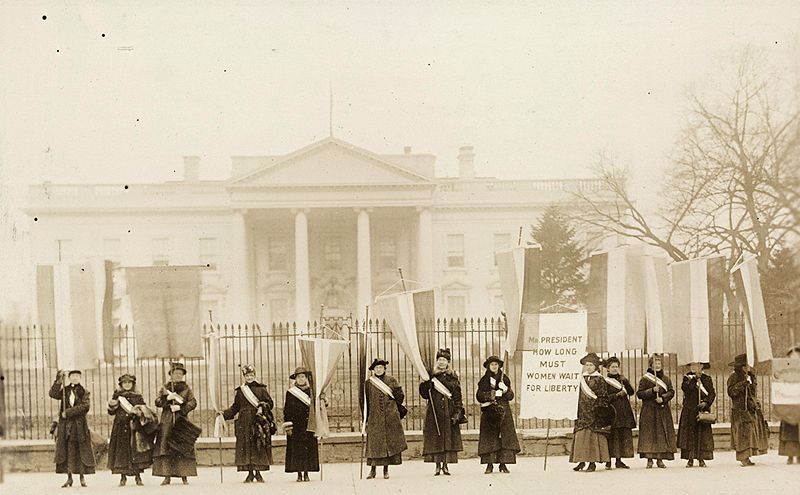History of Laughter
Historian Peter Jones on three theories of laughter, humour as a way of doing politics and how laughter was pe...

Feminism is the recognition that throughout history, people have been treated differently based on their biological sex as well as on the prevailing understanding of gender norms at any given time. On the basis of those factors, societies have accorded unequal degrees of power to men and women, which has had clear and concrete effects on people’s lives. The views on sex and gender have structured and reinforced wage inequities, discriminatory treatment at work or in school, unequal access to resources, and political power. And on top of that, most societies have resorted to organized and individual violence to reinforce those sex and gender norms.
Violence against women, against people who are perceived as female, and against those who identify as women, such as trans women, has until very recently been normalized in most societies. Women have suffered violence disproportionately at the hands of men in all historical eras and in all parts of the world. This violence against women has taken many forms: from official and organized – as in systematic rape of women by armies in times of war – to ones that take place in the context of home and family: domestic violence and intimate partner violence. Some forms have also taken place in contexts of unequal social power, for example, sexual assault on college campuses. And feminism is simply the recognition that all of those forces have affected women’s lives and the determination to organize to try to address those injustices and create an equal society.
There is no one feminism. There are many feminisms, so when you consider the history of feminism, you have to take into account many different kinds of movements by women and allies of women. Often feminism has intersected with other types of movements, so there have been movements that involved black and white women, poor and rich women, and young and older women, and all of them have had different focuses. And there have also been feminist movements within workers’ movements, labor movements, the civil rights movement, and gay and lesbian movements. There have even been feminist environmental activists. And, though most feminists would not call such women feminists, there have been self-identified racist feminists – women of the Ku Klux Klan and certain groups of Skinhead women.
Another was the antislavery movement. Some of the leading women who spoke out against slavery were told they couldn’t occupy the pulpit or the stage and that to do so was somehow unnatural, and unwomanly. Leaders such as Angelina and Sarah Grimke fought back against that perception and said that women had a right to speak as well. There were also formerly enslaved women like Sojourner Truth, who talked about the notion of chivalry, the idea that women were protected by men. Truth pointed out, in a famous series of speeches in the 1850s, that for slave women, this had never been true. They were forced to work in the fields; they were beaten and raped, and their children were sold away from them. And yet they were women too, Truth famously noted. So on what basis could they be denied the right to vote, to care for and live with their children, and the right to bodily integrity and safety?
In this way, feminism in the US came out of those movements in the 1830s and continued in the movement for women to get the right to vote. Though that movement had many roots, its founding moment is seen by many as having taken place in Seneca Falls, New York, in 1848, where convention delegates composed and ratified a “Declaration of Sentiments” that some have called “A Declaration of the Rights of Woman”. Modeled on the 1776 “Declaration of Independence” and the 1789 “Declaration of the Rights of Man”, it argued that women were equal to men in the eyes of God and that; therefore, they were entitled to the rights to education, property, divorce, custody of their children, protection from violence at the hands of husbands, and – finally – the right to vote. It would take 72 years before they won that vote across the U.S.

Feminism was present in the Civil War, where women served as nurses and volunteers in the field. When they came home, they wanted access to higher education and to various professions. After the Civil War, women fought hard for the right to control their own property since, by law, they couldn’t control their wages or savings. The Married Women’s Property Act of 1884 gave women greater financial independence from their husbands. Male legislators agreed to pass this, in part, so that creditors couldn’t come after male soldiers’ families and take away the wages their wives had earned during the war.
Feminism was present in the 1910s when a vast immigrant labor movement swept across the United States, involving hundreds of thousands of women workers in strikes and protests, and union drives. At that point, and especially after World War One, when the Global Peace movement and the Global Workers movement first appeared, and women started to feel like they were being funneled into wars that were not of their own making, a more global feminism emerged. There was the International Women’s League for Peace and Freedom, the International Federation of Women Workers, and many other transnational women’s federations that met throughout the 1910s and into the inter-war years.
After World War Two, Eleanor Roosevelt and women delegates from many different countries forged the United Nations Convention on the Rights of Women around the World. That eventually passed the United Nations in 1979 as CEDAW – the Convention on the Elimination of All Forms of Discrimination Against Women. To this day, women around the world turn to that convention as a way of guaranteeing their rights. International Women’s gatherings started in 1975 in Mexico City, in 1977 in Houston, and in 1995 in Beijing.
Right now, in the 21st century, there is a global uprising of poor and low-wage workers and farmers around the world, a majority of whom are women and mothers, particularly women of color. They are leading global campaigns against neoliberalism and the environmental plunder, land grabs, and mass evictions that have occurred around the world since 1995. These are women’s movements as well. Among the key issues galvanizing these movements are concerns that are particular to women – sexual violence, pregnancy discrimination, and gender-based wage inequities. Alongside these workers today, the World March of Women has organized tens of thousands of women from Montreal to Mozambique, from Turkey to Tampa – to march against land expropriations, farm evictions, war profiteering, and for a living wage for women, safe streets and union rights. Finally, in the last few years, there has also been a movement among women students to fight rape on college campuses. All of these are the faces of 21st-century feminism.

Who were the best-known faces of early American feminism? One was Sojourner Truth, the aforementioned formerly enslaved mother who was an activist and an orator for women’s rights throughout the 1850s, 60s, and 70s. She was extremely important in pointing out that this notion of women as being helpless and weak was wrong. These misconceptions contributed to stereotyping of working and enslaved women, and women of color, as somehow unnatural, as masculine, as something other than just women. Her arguments were truly important in breaking down the notion of separate spheres – with men in a bruising world of work and women in a pious, isolated home raising their children. She made clear how much this was a vision of womanhood rooted in class and race prescriptions.
Another important African-American activist was Ida Wells Barnett, who was a journalist and a campaigner against lynching. She traveled around the world, arguing that sexual violence was closely tied to racism and segregation in the American South. She also argued that underpinning that system was white men’s access to black women’s bodies in slavery and afterward. The excuse for lynching was the notion that black men were raping white women, but, as Wells Barnett wrote, that covered over the reality of consensual relationships between black men and white women. She was way before her time in making such connections, and they were so controversial that her newspaper office was bombed, driving her out of the South. After a world tour during which she described the violence of lynching, she eventually settled in Chicago – where she became active in labor and women’s suffrage as well as civil rights work.
Then there were the two most famous figures of American white feminism in the 19th century — Elizabeth Cady Stanton of New York and Susan B. Anthony. They organized for many years to get the vote for women in the US. They published a newspaper called “The Revolution,” which was very militant in arguing that after the Civil War, it was time for women to focus intently on sex discrimination. They orchestrated civil disobedience campaigns through which women voted illegally before they ever had the vote. These two women were really crucial in terms of changing the law in the 1860s and 70s.
In the early part of the 20th century, there were the British suffragists Emmeline, Sylvia, and Christabel Pankhurst, who really revved up civil disobedience to try to get women the vote, throwing themselves in front of the horse-drawn carriages of royals and parliament members. In Europe in that period, there were also radical activists, Alexandra Kollontai in Russia and Rosa Luxemburg in Germany, who tried to figure out how sex discrimination and the oppression of the working class went together. They were key in the early formulations of Marxist feminism.
The list goes on into the 1960s and 1970s feminist uprisings, but one other important figure from the early 20th century through the 1930s was the anarchist feminist Emma Goldman. She was a Russian-Jewish immigrant to the US who was expelled in the “Red Scare” after World War I and sent back to Russia. She was expelled from there in 1922, sent to France, and then ended up in Spain during the anarchist revolution in the 1930s. National elites kept throwing her out of one country after another because she argued for women’s complete freedom over their bodies, for birth control, recognition and decriminalization of homosexuality, and for people to be able to live freely. What got her expelled from the U.S. was her draft resistance. She believed that it was a violation of human rights to force a young person to serve in the military, to risk his or her life, and to be forced to kill others. So Goldman is one of those really important figures, tying together feminism in many different countries.
In the 1960s and 70s, there were many important feminists. There was a very influential group in New York. Among them were Kate Millett, who wrote Sexual Politics, and the journalist Betty Friedan. Friedan, a former labor journalist and then a writer for women’s magazines, published The Feminine Mystique in 1963. This was a bombshell book that helped middle class women see why they felt trapped by simply being seen as wives and mothers, not as individuals and professionals. Friedan worked alongside the mixed-race, gender non-conformist attorney Pauli Murray. The two were among the group that founded the National Organization for Women in 1966. Murray coined the term “Jane Crow” to refer to the system of laws that discriminated against women. Though Murray was the author of an analysis of Southern Jim Crow laws that future Supreme Court Justice Thurgood Marshall called “the bible of the civil rights movement,” she believed that Jane Crow was as powerful in restricting women as Jim Crow segregation was in keeping black people down.
Ruth Bader Ginsburg, a current Justice of the United States Supreme Court, was a hugely important figure in the 1970s in changing the law to make it fairer and more equitable for women. She founded the American Civil Liberties Union Women’s Rights Project in the 1970s, and she argued numerous key cases before the Supreme Court that dramatically expanded American women’s rights. Her role really cannot be overstated. It was as a result of her litigation before the Court and her decisions once on it that many of the rights we now take for granted were won. Interestingly, she was deeply influenced by Pauli Murray and even co-signed Murray’s name to one of her most influential early briefs.
Lastly, though there were many more activists, one name that needs to be mentioned is Evie Windsor, an elderly lesbian who was almost put out of her house after the death of her partner in 2008. She launched a suit for equal marriage rights so she could stay in her apartment and wouldn’t have to pay estate taxes so high that she would have been forced to leave her home. She argued that if her marriage to her partner, Thea, had been recognized, she would have been taxed at the rate of a spouse rather than of a stranger (a much higher rate.) Her suit went on to become the landmark 2013 case Windsor vs. the United States. This was the case that made same-sex marriage legal throughout the US.

Of course, if you think about feminism on a global scale, there are many more notable activists that haven’t yet been mentioned here. But three important figures from recent years particularly stand out. The first is Wangari Maathai, a Kenyan activist who pioneered what she called “The Green Belt Movement.” It eventually involved upwards of 50,000 women who planted trees in areas of sub-Saharan Africa that had been deforested by the colonial powers. She helped create an environment that enabled women once again to support themselves and their families as small farmers. This struck a crucial blow for women’s autonomy in a number of patriarchal cultures, and Maathai was targeted for it. It’s also important to mention the recently murdered Berta Caceres from Honduras, who killed fighting for land rights for indigenous people whose traditional home was leased to foreign corporations seeking to build a dam. Finally, we should pay tribute to Kalpona Akter, leader of the Bangladesh garment workers movement, whose tireless advocacy and hard work building a global coalition of labor, student, and consumer groups resulted in the Bangladesh Fire and Safety Accord, now signed by over 200 corporations that make clothing in Bangladesh for sale in Europe, the U.S., and Asia. They, too, are part of a global feminism that’s tied together by a desire for respect, dignity, and recognition of women’s contributions.
Many movements have been important to the history of feminism. To begin with, the women’s labor movement played a huge role. It was important in the US in the 1830s and in the 1910s, and it continues to be important around the world today, in 2016. A disproportionate share of low-wage workers are women, and, in particular, women of color, in various parts of the world. Their campaign for a living wage is extremely important and has been throughout history.
Next, there is the campaign for political rights, the women’s suffrage movements in the US, France, in England, as well as various parts of Africa and the Middle East. These have been crucial. To those can be added the campaign for legal rights waged by lawyers and judges like Ruth Bader Ginsburg and Pauli Murray.
Lesbian feminism has been an extremely significant movement, both in its own right from the 1940s to the present, working to make life safer for lesbians and their children, but also because lesbian feminists have been disproportionately involved in other people’s movements: the civil rights movement, the peace movements, and many others. Lesbian feminists have been very active in the campaign for the rights of people with AIDS, even though they themselves had a very low incidence of AIDS.

Via Campesina, the feminist movement of small farmers is really key now. A majority of small farmers around the world today are women who are maintaining and sustaining their families. The campaign for “food sovereignty” that they are waging now is an important mothers’ campaign. And it is a vital counter-force to the corporatization of food production. Its leader Elizabeth Mpofu of Zimbabwe, argues that 70 million women farmers can feed the world, doing more to end world hunger than all the misguided projects of the World Bank and the International Monetary Fund. Mothers like these have been really crucial in many movements, so it is not a surprise that it is mothers who are energizing the movement to keep small farmers on their lands and to fight against pollution and dam construction.
Feminism has faced myriad difficulties and continues to do so. Perhaps the biggest was political disenfranchisement: women had no vote, in many countries, until the middle of the 20th century. Without the vote, it was difficult to get elected officials to listen to them. Secondly, women have always had less money than men, and they still do. With the lack of economic resources, they were unable to pursue their battles very easily – they needed to have allies, and women with more means would often help others.

The third biggest obstacle has been violence against women. Sexual violence has always been used as a way to keep women in their place, on campuses, in times of war, and in many different contexts. And women have also been beaten to keep them from organizing. The idea that police or military or private security guards will not beat women is simply not true. African-American voting rights activist Fannie Lou Hamer was beaten until her skin turned blue.
The fourth important factor that women also still face is the contempt with which feminist movements are treated. There is widespread derision towards feminists in the U.S. and around the world. This is an attempt to keep women in line by calling them names, telling them that they are not real women, that they are like men, or frigid, or bitches – all of those ideas are used to weaken and divide feminist movements.
That has been the last major obstacle, division within feminist movements. This is only to be expected because women constitute half of the human race. There will never be a time or place when all women can unite around all issues. Feminist leaders have not always been able to unite women. Indeed, they have often made mistakes that have driven a wedge between women.
The most obvious and damaging were by some of the white middle-class feminist leaders who assumed that their concerns were the same as the concerns of poor women, women of color, or lesbian women when they were quite different. After women got the vote in the U.S., Alice Paul, founder of the National Women’s Party (NWP) and a fierce advocate first for the vote and then for an Equal Rights Amendment to the U.S. Constitution, was approached by black women who still didn’t have the right to vote in the American South. They were kept from voting in 1920 (and through the mid-1960s) because they were black. Though millions of African-American women were being denied the right to vote, the NWP refused to help because they claimed that this was a race issue, not a women’s issue. Paul and the NWP pushed an Equal Rights Amendment, though, as worded, it would have invalidated labor laws protecting millions of women workers.

Many decades later, Betty Friedan tried to keep the National Organization for Women (NOW) from fighting for the rights of lesbians, calling them a “lavender menace” who distracted from the larger issues facing women and whose participation in the women’s movement made feminism look bad. Eventually, lesbian activists, including Del Martin, Phyllis Lyon, and Rita Mae Brown, convinced the organization to reform. And in 1971, it passed a resolution affirming women’s right to express their full selves openly, including sexuality.
Today, in 2016, a big problem for feminism is this generation of millennial women and men who believe that women have basically achieved equality. It is true that great strides have been made as a result of the labors of all of the activists who have come before us. Women can now take out mortgages and get business loans. Half of the medical students and law students in the U.S. are women, but there is still a lot of work that needs to be done. Sexual violence is an epidemic, and we have a long way to go in fighting it in our culture. In popular culture, there is also a lot that still needs to be addressed – the normalization of violence against women in popular songs and music videos, the concentration of women among the lowest-paid and most exploited of the world’s workers, the relatively small numbers of women in positions of political power. So there is a lot of work to be done by the next generation of feminists.
Edited by Alina Shubina

Historian Peter Jones on three theories of laughter, humour as a way of doing politics and how laughter was pe...

Historian Mark Jarzombek on the notion of seemingly primitive, worldwide evolution of the housing, and the fat...

Sociologist Peter Kivisto on Eugen Weber, settler states, and Jihadist terrorism